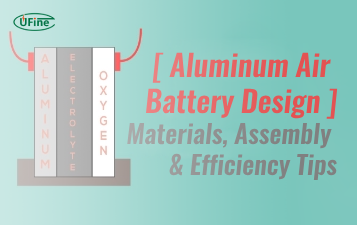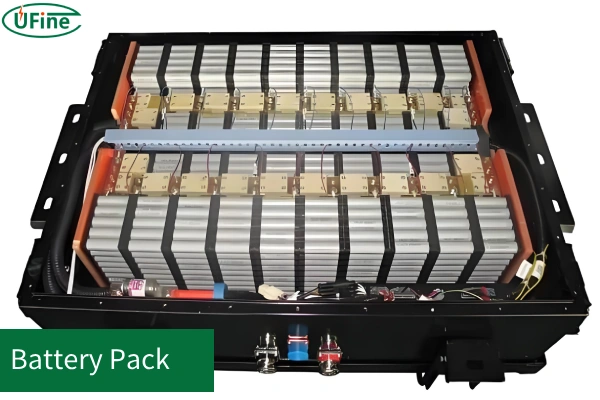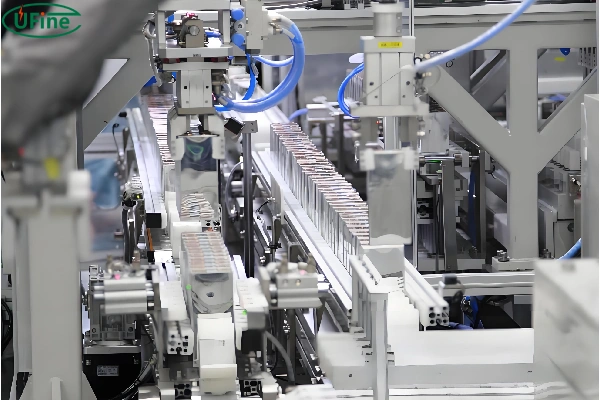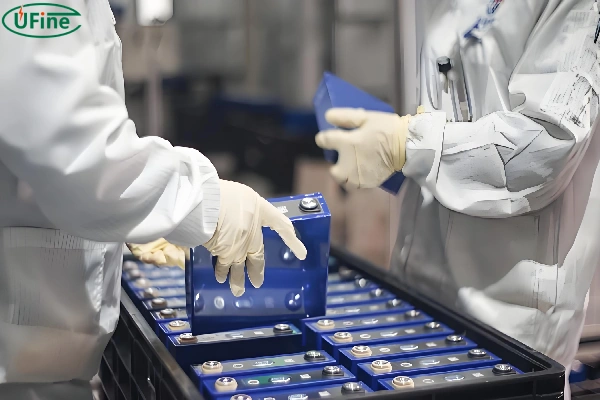In the electrochemical energy storage track, lithium-ion battery energy storage is the most mature technology and has the fastest development momentum. Among them, lithium-ion battery pack technology is an extremely important part. What exactly is a battery pack? What is its complete production line like? Find out with Ufine!
Part 1. What is a battery pack?
The lithium-ion battery pack is a manufacturing process for lithium-ion batteries. When packing a battery, multiple lithium-ion single-cell groups are connected in parallel and in series. Unlike a single cell, a battery pack requires and considers the mechanical strength, thermal management, BMS matching, and other issues of the entire battery system.
The important technologies of lithium-ion battery packs are reflected in the overall structural design, welding and processing technology control, protection level, active thermal management system, etc. For example, PACK connects two batteries in series or in parallel to form a certain shape according to customer requirements.
Part 2. Battery pack composition
The important components of the battery pack include five parts: a single battery module, an electrical system, a thermal management system, a box, and BMS.
1. Battery module:
If the battery pack is compared to a human body, then the module is the “heart,” responsible for the storage and release of electrical energy.
2. Electrical system:
The electrical system of the battery pack is mainly composed of connecting copper bars, high-voltage wiring harnesses, low-voltage wiring harnesses, and electrical guarantee devices. The high-voltage wiring harness can be regarded as the “aorta” of the battery pack, which continuously transmits the battery power to the end load. The low-voltage wiring harness is the “neural network” of the battery pack, which transmits detection and control signals in real-time.
3. Thermal management system
Thermal management systems mainly use two methods: air cooling and liquid cooling. Liquid cooling can be divided into cold plate liquid cooling and immersion liquid cooling.
The thermal management system is equivalent to installing an air conditioner for the battery pack. The battery generates heat in the discharge mode. In order to ensure that the battery works at a reasonable ambient temperature and improve the battery cycle life, the battery one system temperature difference is required to be ≤5℃.
There are many assembly types of air cooling systems. Its core components are mainly compressors, fans, heat exchangers, etc.
4. Box:
The box of the battery pack is mainly composed of the box, box cover, metal bracket, panel, and fixing screws. The box can be regarded as the “skeleton” of the battery pack. It plays the role of support, mechanical shock resistance, mechanical vibration, and environmental protection.
5. BMS:
BMS is the abbreviation of “Battery management system,” which can be compared to the “brain” of the battery. BMS is mainly responsible for measuring battery voltage, current, and temperature parameters, and it also has functions such as balancing. BMS can transmit data to MES.
Part 3. Characteristics of the battery pack
- The lithium battery pack requires the battery to have a high degree of consistency (capacity, internal resistance, voltage, discharge curve, life);
- The cycle life of the battery pack is lower than the cycle life of a single battery;
- The battery pack needs to be used under limited conditions (including charging and discharging current, charging method, temperature, etc.);
- After the lithium battery pack is formed, the voltage and capacity are greatly improved and must be protected. It needs to be charged and balanced, and temperature, voltage, and overcurrent monitoring are required;
- The battery pack must meet the voltage and capacity requirements of the design.
Part 4. How to pack the battery?
1. Series-parallel composition
The battery module is composed of single cells connected in parallel and series. The battery increases the capacity by connecting in parallel, and the voltage remains unchanged. After battery one is connected in series, the voltage doubles and the capacity remains unchanged.
For example, in a cell with a voltage of 3.2V, 15 cells connected in series are 48V, which is a series voltage boost;
For example, in a cell with a capacity of 50Ah, two cells connected in parallel have 100Ah, which is a parallel capacity expansion.
2. How to select cells:
Select the corresponding cells according to the design requirements. The types of batteries in parallel and series must be the same. The battery models must also be the same. These cells’ capacity, internal resistance, and voltage values differ by no more than 2%. Multiple strings are required whether it is a pouch battery or a cylindrical battery.
3. Battery pack process
Battery packing is achieved in two ways.
- The first method is laser welding, ultrasonic welding, or pulse welding, which is a commonly used welding method. The advantage of this method is that it is reliable, but it is not easy to replace.
- The second way is through elastic metal sheet contact. The advantage of this method is that no welding is required. The battery is easy to replace. The disadvantage is that it may cause poor contact.
Considering factors such as production qualification rate, efficiency, and internal resistance of connection points, laser welding is currently the first choice for many battery manufacturers.
Part 5. What is a complete battery pack production line?
The lithium battery pack production line refers to a system collection of equipment and process flows required to produce lithium battery packs.
The lithium battery pack production line usually includes six core links: battery cell manufacturing, battery cell testing, battery cell grading, battery cell assembly, packaging, and quality inspection. Among these links, battery cell manufacturing and assembly are the most core. They directly affect the performance and quality of lithium battery packs.
1. Battery cell manufacturing
Battery cell manufacturing is the first link in the production line. It can be divided into the preparation of positive and negative electrode materials, battery cell forming, battery cell injection, and battery cell finished products.
Cell forming is the most critical step, and there are winding forming, stacking forming, and stamping forming methods. These determine the shape and size of the cell, which will directly affect the performance and life of the cell.
Different forming methods are suitable for different lithium battery products, depending on the situation.
2. Cell testing:
This process mainly screens out cells with unqualified quality to ensure the smooth progress of subsequent production links.
Cell testing mainly includes cell capacity testing, cell internal resistance testing, and cell temperature testing. These test items can help manufacturers understand the cell’s performance, find problems in time, and make adjustments and optimizations.
Part 6. How to understand the battery pack parameters?
Take the above parameters as an example.
1. Battery combination: 1P24S
S represents series cells, P represents parallel cells, and 1P24S means 24 series and one parallel.
After the series connection, the voltage doubles, and the rated voltage is 3.2*24=76.8V.
2. Rated capacity: 280Ah
The rated capacity of a battery refers to the capacity that can work continuously for a long time in underrated working conditions. The rated capacity of a battery, C, is measured in ampere-hours (Ah). It is the product of the discharge current (A) and the discharge time (h). So 280Ah means the battery can be continuously discharged for 2 hours at a maximum rate of 0.5C.
3. Rated energy: 21.504kWh
Rated energy (Wh) = nominal capacity (Ah) * nominal voltage (V. This also means that the total energy a battery releases is related to the capacity and voltage.
Part 7. Lithium battery pack development trend
With the continuous expansion of the battery market, the pack production line is also constantly improving to improve the performance and quality of the battery pack. The pack link will change from labor to technology when automation becomes popular. The future battery pack will work hard on parameter matching and battery pack design, and machines will handle the rest.
In the future, the technical direction of the lithium battery pack production line will mainly include the following aspects:
- Intelligence: By introducing technologies such as artificial intelligence and the Internet of Things, the automation, intelligence, and informatization of the production line will be realized to improve production efficiency and product quality.
- Greening: By adopting environmentally friendly materials, energy conservation, and emission reduction measures, the greening and sustainable development of the production process will be realized.
- Personalization: According to the needs and requirements of different customers, the personalized customization and service of the production line will be realized to improve customer satisfaction and loyalty.
- Safety: By strengthening safety management and risk control, the safety and stability of the production process will be guaranteed.
Related Tags:
More Articles

Aluminum Air Battery Design: Materials, Assembly & Efficiency Tips
An aluminum air battery uses aluminum and air to generate power. Learn its materials, assembly steps, and tips to boost energy output and efficiency.
7 Advantages of a Heated Lithium Battery in Cold Climates
Looking to power batteries in freezing temps? Heated lithium batteries excel in cold climates. Here are 7 key benefits and how they work.
How to Choose the Best Floor Scrubber Battery for Commercial Cleaning?
Selecting the ideal floor scrubber battery ensures a long runtime, rapid charging, and minimal maintenance for efficient commercial cleaning operations.
Battery for Blower vs Battery for Leaf Vacuum: Which One Should You Choose?
Battery for blower vs leaf vacuum—learn the key differences in power, fit, and runtime to choose the right battery for your outdoor tool needs.
How to Choose the Right Battery for Blower?
Choosing the right blower battery? Consider voltage, capacity, chemistry & usage. This guide helps match the best battery for peak performance.






